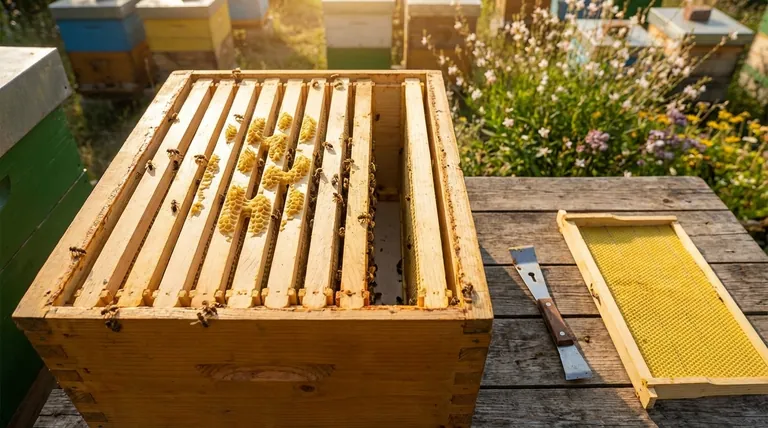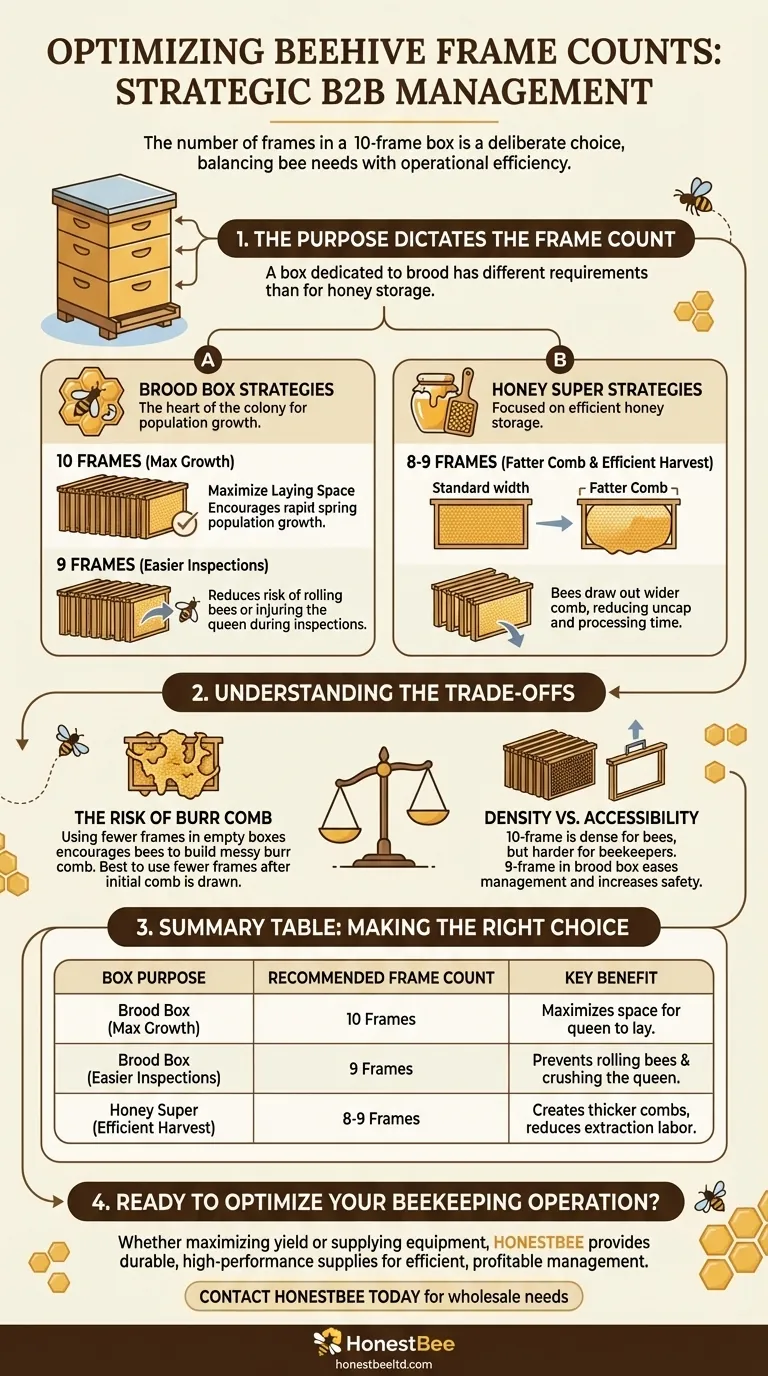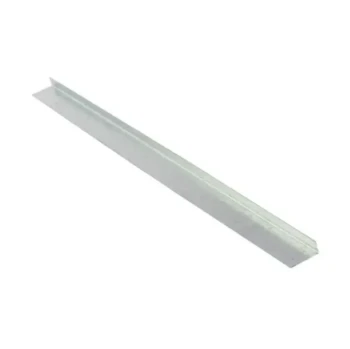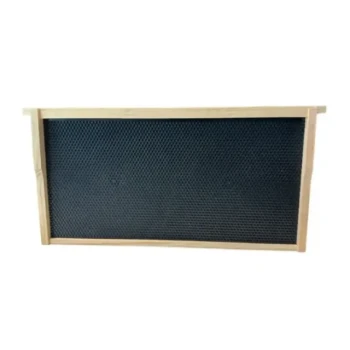The number of frames in a 10-frame beehive box is not always ten. While a 10-frame box is designed to hold ten frames, many experienced beekeepers strategically use nine, eight, or even seven frames depending on the purpose of the box and the time of year.
The optimal number of frames is a deliberate choice that balances the bees' need for space against the beekeeper's need for manageable inspections and efficient honey extraction.

The Purpose of the Box Dictates the Frame Count
The most important factor in deciding how many frames to use is the function of the specific hive box. A box dedicated to raising brood has different requirements than one used purely for honey storage.
For Brood Boxes: The Case for 10 Frames
The brood box is the heart of the colony where the queen lays her eggs and new bees are raised.
Using the full ten frames provides the maximum possible space for the queen to lay. This encourages rapid population growth, which is critical for building a strong, healthy colony, especially in the spring.
For Brood Boxes: The Practicality of 9 Frames
Many beekeepers choose to run only nine frames in their 10-frame brood boxes.
This practice, often called "running 9 in a 10," creates slightly more space between each frame. This extra room makes it significantly easier to remove the first frame during an inspection without rolling bees or damaging adjacent comb. It also helps prevent injuring the queen, who can be crushed between tightly packed frames.
Optimizing Your Honey Supers
A honey super is any box placed above the brood box with the sole purpose of honey storage. Here, efficiency for the beekeeper becomes a primary goal.
Why Fewer Frames Mean Fatter Comb
When you use fewer frames (typically 8 or 9) in a honey super, you give the bees more space between them.
The bees will naturally extend the wax cells, drawing out the comb to be much wider than usual. This results in "fat" combs, each holding significantly more honey than a standard-width comb.
The Benefit for Extraction
The true advantage of this method is realized during harvest. Because each frame holds more honey, you have fewer frames to uncap, handle, and process in your extractor.
This dramatically reduces the time and labor involved in honey extraction, a key consideration for any beekeeper with more than a couple of hives.
Understanding the Trade-offs
Choosing your frame count involves balancing benefits with potential downsides. There is no single "correct" answer, only the best approach for a specific situation.
The Risk of "Burr Comb"
The biggest risk of providing too much space is the creation of burr comb. This is wild, irregular comb that bees build to fill any gap they deem too large.
Using only eight or nine frames in a box that does not yet have established, drawn comb can encourage bees to build messy burr comb between the frames, making inspections difficult and frustrating. It's best to use fewer frames only after the bees have initially built out the comb on all ten.
The Density vs. Accessibility Dilemma
The core trade-off is simple. A 10-frame configuration is dense, maximizing space for the bees but making it harder for the beekeeper to work.
A 9-frame configuration in the brood box slightly reduces the total space for brood but makes hive management and inspections much easier and safer for the bees.
Making the Right Choice for Your Goal
Your beekeeping goals should guide your decision on how many frames to use in each box.
- If your primary focus is maximum colony growth: Use the full 10 frames in your brood boxes to give the queen ample laying space.
- If your primary focus is easier hive inspections: Use 9 frames in your brood boxes to reduce the risk of rolling your queen and damaging comb.
- If your primary focus is efficient honey harvesting: Use 8 or 9 frames in your honey supers after the bees have initially drawn out the comb.
Understanding how to manipulate frame spacing is a key step toward managing your hives with intention and purpose.
Summary Table:
| Box Purpose | Recommended Frame Count | Key Benefit |
|---|---|---|
| Brood Box (Max Growth) | 10 Frames | Maximizes space for queen to lay eggs and build colony strength. |
| Brood Box (Easier Inspections) | 9 Frames | Prevents rolling bees and crushing the queen during hive checks. |
| Honey Super (Efficient Harvest) | 8-9 Frames | Creates thicker honeycombs, reducing labor during extraction. |
Ready to optimize your beekeeping operation?
Whether you're a commercial apiary focused on maximizing honey yield or a distributor supplying top-tier equipment, the right tools make all the difference. HONESTBEE supplies durable, high-performance beekeeping supplies and equipment through wholesale-focused operations, helping you manage your hives more efficiently and profitably.
Contact HONESTBEE today to discuss your wholesale needs and discover how our equipment can support your beekeeping goals.
Visual Guide

Related Products
- Assembled Wooden Bee Frames with Beeswax Foundation Ready to Use by HONESTBEE
- Heavy-Duty Stainless Steel Clip-On Frame Perch
- Professional Galvanized Steel Frame Rest for Beehives
- Assembled Wooden Bee Frames with Plastic Foundation for Durability and Convenience by HONESTBEE
- HONESTBEE Advanced Ergonomic Stainless Steel Hive Tool for Beekeeping
People Also Ask
- Can I reuse old frames? A practical guide to saving money and reducing waste
- What are bee frames, and how do they relate to box sizes? A Guide to the Langstroth Hive System
- What are the advantages of using wooden beehive frames? Natural, Sustainable, and Bee-Friendly
- What are some tips for setting up hive frames? Build a Strong Foundation for Your Hive
- How many frames fit in a 10 frame hive? A Guide to Maximizing Your Hive's Potential



















